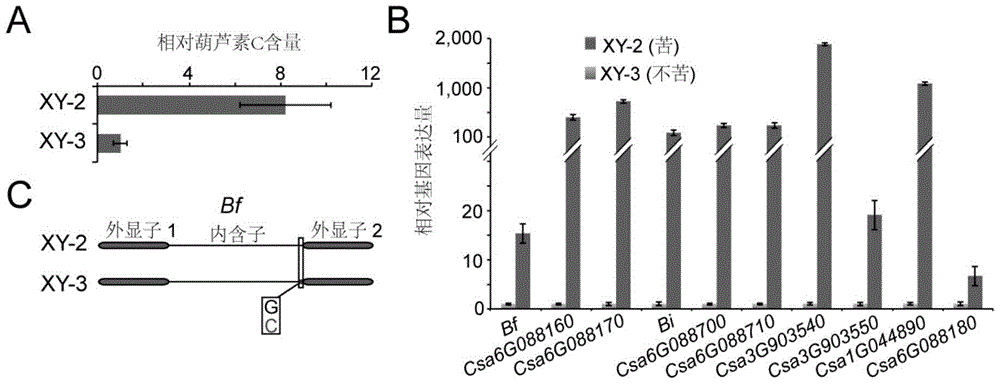Transcription factor csa5g157230 involved in regulating the synthesis of cucurbitacin c in cucumber and its application
A technology of transcription factor and cucurbitacin, applied in the fields of genetic engineering and molecular biology, can solve the problems of unclear molecular mechanism and uncloned synthetic genes.
- Summary
- Abstract
- Description
- Claims
- Application Information
AI Technical Summary
Problems solved by technology
Method used
Image
Examples
Embodiment 1
[0026] Example 1 Mining and acquisition of transcription factors regulating the synthesis of cucumber cucurbitacin C
[0027] 1. Mining of candidate genes
[0028] A cucumber mutant (XY-3) with no bitter taste was found in Hunan, which was naturally mutated from bitter cucumber (XY-2) ( figure 1 , A). In the mutant XY-3, the expression level of the bitter taste synthesis gene cluster was very low in the mutant ( figure 1 , B), it is speculated that the gene that regulates the synthesis of bitter taste may be mutated in this mutant. The genomic DNA of XY-2 and XY-3 were resequenced. Using bioinformatics analysis, look for internal mutations that occur in transcription factors. This analysis found a SNP located inside the transcription factor Csa5G156220 ( figure 1 , C). Transcriptome data showed that the gene was only abundantly expressed in leaves, and the expression of the transcription factor was also greatly reduced in the mutant ( figure 1 , B). In addition, stress...
Embodiment 2
[0038] Example 2 Using the Agrobacterium-mediated transient expression method to verify the function of transcription factors that control the synthesis of cucumber bitterness
[0039] Since the stable cucumber transgenic system is immature, a transient expression system for cucumber cotyledon and fruit was established in this example to further verify the functions of Bf and Bt.
[0040] Csa5G156220 (SEQ ID No. 2) and Csa5G157230 genes (SEQ ID No. 3) were constructed on the binary vector pBIN-Plus. They were respectively introduced into Agrobacterium EA105 by chemical transformation. Agrobacterium containing Csa5G156220 gene was cultivated to OD 600 About 1.0, then diluted to OD with injection buffer 600 About 0.3 or so, use a syringe without a needle to inject Agrobacterium into the cotyledon of cucumber seedlings about 10 days old. One week later, the leaves were collected, and the compounds in the leaves were extracted with methanol, followed by UPLC-Q-TOF (Agilent) det...
PUM
 Login to View More
Login to View More Abstract
Description
Claims
Application Information
 Login to View More
Login to View More - R&D
- Intellectual Property
- Life Sciences
- Materials
- Tech Scout
- Unparalleled Data Quality
- Higher Quality Content
- 60% Fewer Hallucinations
Browse by: Latest US Patents, China's latest patents, Technical Efficacy Thesaurus, Application Domain, Technology Topic, Popular Technical Reports.
© 2025 PatSnap. All rights reserved.Legal|Privacy policy|Modern Slavery Act Transparency Statement|Sitemap|About US| Contact US: help@patsnap.com



